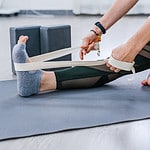Introduction
Knee pain is a common issue for soccer players. When not treated, it can get worse and cause joint pain, especially in the knee. Thankfully, there are joint-friendly exercises to help. Below are some examples that can reduce knee discomfort and help soccer players stay active. Remember to use proper form, such as not locking the knees during stretches or exercise. If pain continues, consult a doctor before attempting any exercise.
- Stretches
- Strength training exercises
- Balance exercises
- Aerobic exercises
Warm-up Exercises
Warm-up exercises are a must for soccer players. Especially those with knee pain! Stretching the muscles and ligaments around the knee boosts mobility and reduces injury risk. Boosting blood flow to the knee decreases inflammation and helps healing.
Here we look at joint-friendly warm-up exercises for soccer players with knee pain:
Quadriceps stretch
The quadriceps stretch is a must for soccer players. It prevents knee pain and injuries. This stretch targets the front of the thigh muscles. You hold onto one foot while keeping the knee pointing down.
Then, bend your other leg at the knee.
To do it right:
- Stand up straight with feet together
- Balance with hands on hips or a wall
- Grab one foot with both hands, bring it up to the buttock or lower back
- Keep the knee pointing down
- Hold for 10-15 seconds, repeat 2-3 times
- Switch sides
Activate your core muscles to get a deeper sensation in your quads, calves and hips. Breathe deeply for more flexibility. Be careful not to push too hard or too quickly. If you have ankle, knee or hip issues, take extra care when stretching.
Gluteus stretch
The gluteus stretch is a warm-up exercise that helps reduce tension in the glutes and hamstrings. Don’t overstretch one side.
- Stand with your feet hip-distance apart and your toes facing forward. Bend your knees slightly. Push your hips back, keeping your spine straight. Hold this position for 15-20 seconds. Repeat three times.
- Get a belt or get help from a partner to hold your ankles in place. Bend from the hips and fold your waist. Place both arms on one leg for support. Breathe deeply for 5 breaths or 30 seconds. Repeat three times.
For a modification, sit on a chair with both legs extended in front of you. Flex one foot and grab it by its heel. Use a belt for extra tension relief. Lean forward until you feel a light stretch. Hold for 15-20 seconds. Do 3 sets per side. Enjoy!
Groin stretch
The groin stretch is a must for soccer players with knee pain. It helps to increase motion in the hip joint, improve flexibility in the abs, and give stability and balance to the lower body.
To perform the groin stretch:
- Start by standing with feet wider than shoulders, toes out.
- Lean forward from hips and reach both hands toward feet as far as is comfortable. You should feel a gentle pull in your thigh muscles and groin area.
- Hold for 15-20 seconds before standing up again.
- Do this 5-6 times as part of a warm-up for soccer practice or jogging or walking.
Hamstring stretch
The hamstring stretch is perfect for soccer players who have knee pain. Start slowly and build intensity as you loosen up. To begin, stand with feet shoulder-width apart. Stretch your arms in front of you. Bend at your waist. Keep your back straight. As you lower, you’ll feel a gentle stretch in the back of each leg around the hips and hamstrings. Hold for 10-15 seconds before standing up. Repeat 3-5 times. Then move on to other joint-friendly warm-up exercises such as calf raises or a basic quadriceps stretch. Doing this regularly can help you move around the soccer field without straining your knee pain.
Strengthening Exercises
Soccer players: to reduce knee pain, strengthen the muscles around it! Squats and lunges are great lower body exercises. This builds up the muscles and takes strain off the knee joint. So less pain!
We are here to discuss exercises which are specially designed to strengthen knee muscles:
Step-ups
Step-ups are an easy and useful exercise for soccer players with knee pain. They help build strength in the muscles that support the knee joint. Here’s how to do one:
- Stand perpendicular to a bench or stair.
- Put one foot onto it, making sure the entire foot is firmly in place.
- Push off your heel to lift the other leg up to the same level. Keep your core tight and spine straight.
- Then, extend both legs until you’re standing upright.
- To finish, lower both feet back to their starting positions.
An important safety tip is not to let either knee bow inwards. Don’t turn the step-up into a squat. This might give some immediate relief, but it weakens the muscles in the long run. Move slowly and do controlled movements. Incorporate this exercise into a program focusing on the big four muscles that help with knee mobility: quadriceps, hamstrings, abductors, and adductors.
Squats
Squats are key for many sports, such as soccer. They strengthen the muscles around the knee and help the knee joint align. To squat properly, keep your weight on your heels and don’t hunch over. This will help the knee joint not take too much pressure.
Begin with feet shoulder width apart. Dip lower than parallel and rise. Focus on engaging the posterior muscle group for stability. Do 10-15 reps with legs no wider than hip width. Keep feet planted firmly in the ground.
As you get better, try squatting parallel or with weight. But don’t do this until you have good form. Too much weight on an unsteady movement can lead to injury.
Lunges
Lunges are great for targeting lower body muscles needed for power and endurance in soccer. Make sure to keep the knee above the foot/toes while doing them. Bad form can cause pain.
Start with basic forward lunges. When you’re able to handle it, move onto lateral and diagonal versions. Use proper weight training principles, like lowering slowly and with control. This strengthens knee muscles, helping joint tracking during sports. Visualize pushing the floor away from your foot when doing forward lunges. This teaches your body to use muscles around the knee for power.
Soccer players running on hard surfaces need healthy knees. These exercises strengthen the muscles, reduce pain, and help avoid future injuries.
Single-leg deadlifts
Single-leg deadlifts are fab for strengthening the body. They can help reduce knee pain for soccer players, and also improve performance. Muscles in the lower body, such as the glutes, hamstrings, quads and core, are targeted.
To do it correctly:
- Stand on one leg, holding weights in both hands. Keep the other leg slightly in front, off the ground.
- Push weight into the heel. Engage the core and squeeze the glutes to stay balanced and stable.
- Hinge at the hips, lowering the weights until they reach just below the knee. Feel a slight stretch in the glutes or hamstrings, then squeeze up to standing.
- For an extra challenge, try to hold one second at either end of each rep. Do eight reps per side or as many as you can do with good form!
Cool-down Exercises
Cool-down exercises are a must for soccer players with knee pain. They reduce tension in the knee joint and can stop future injuries. Flexibility, sore muscles and range of motion can all be improved with cool-down exercises.
This section is all about exercises that help soccer players with knee pain. Joint-friendly ones.
Foam rolling
Foam rolling can lessen knee pain in soccer players. It requires a foam cylinder or cylinder-shaped roller. You use it to massage your legs, upper body, and back. It puts pressure on the roll, warming up the soft tissues around your knee. It also relieves tension, pain, and stress. This helps reduce stiffness round the knee joint, resulting in better movement and fewer injuries.
To use a foam roller, lie down on it. Put it under your knee or any tight spots on your thigh. Move up and down slowly. Repeat if necessary, till you feel relieved. Foam rolling not only relieves tension in the short term, but also improves muscle flexibility over time. This leads to better performance and reduced risk of injury for soccer.
Static stretching
Static stretching is a type of stretching which involves an individual holding one position for up to 60 seconds. It does not require much effort, and is good for increasing flexibility. It is also good for cooling down after strenuous activity and can be beneficial for soccer players with knee pain.
Examples of static stretches are seated knee circles and quadriceps stretches. These may help reduce knee pain and improve flexibility. Restorative yoga poses such as downward-facing dog and warrior II can also be used in a similar fashion.
Conclusion
To sum up, it is essential for soccer players with knee pain to get advice from a doctor or physiotherapist. Exercises which are kind to the joints can aid in reducing the pain and restoring knee strength, flexibility and coordination.
Moreover, they must use strategies including:
- Rest
- Ice
- Compression
- Elevation
Furthermore, soccer players should be hydrated, dress in the correct exercise clothing and have proper nutrition to decrease the chances of long-term harm to their knees. With correct guidance, soccer players can stay active whilst lessening the chances of further injury.
Frequently Asked Questions
Q1: What are some joint-friendly exercises for soccer players with knee pain?
A1: Some joint-friendly exercises for soccer players with knee pain include stationary biking, swimming, and deep water running. Strengthening exercises, such as leg extensions, squats, and leg curls, are also beneficial.
Q2: Are there any exercises to avoid when dealing with knee pain?
A2: Exercises that involve high-impact activities, such as running and jumping, should be avoided when dealing with knee pain. It is also important to avoid activities that involve sudden or jerky motions, such as soccer or basketball.
Q3: What stretches should soccer players with knee pain do?
A3: Soccer players with knee pain should focus on stretches that target the quadriceps, hamstrings, and calves. Quadriceps stretches, such as the quadriceps stretch, can be done while standing or lying down. Hamstring stretches, such as the seated hamstring stretch, and calf stretches, such as the wall calf stretch, can also be beneficial.





